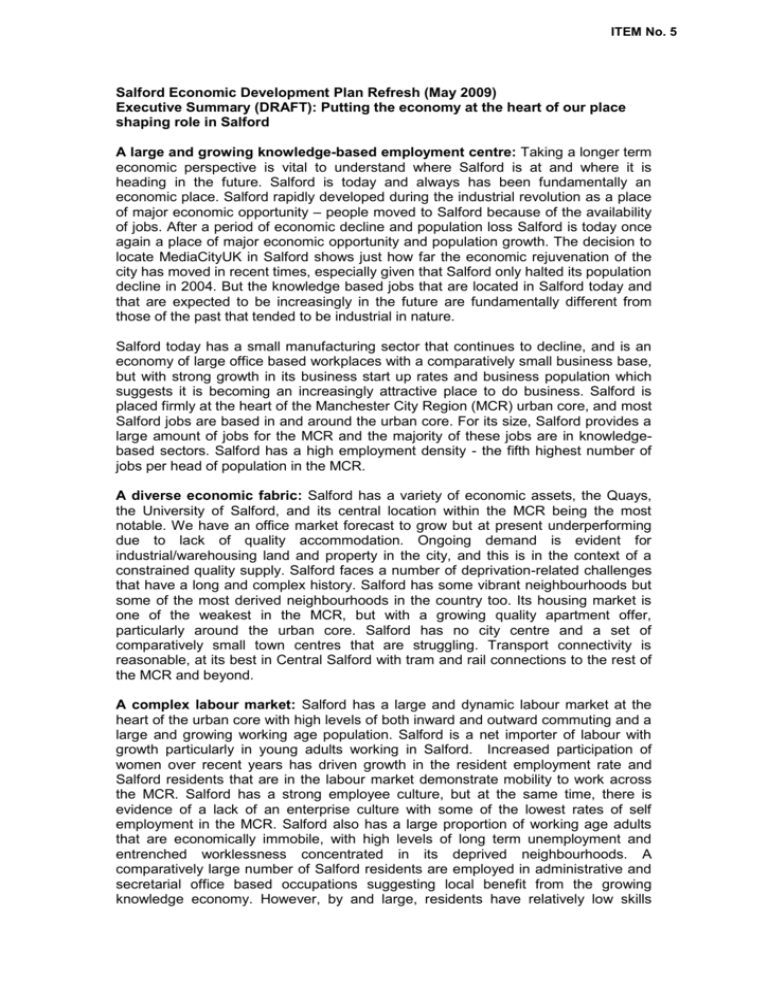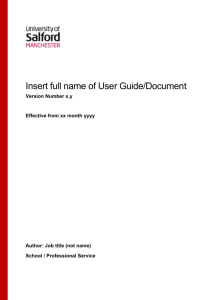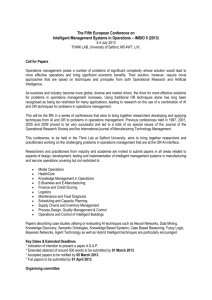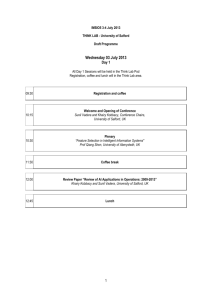Exec summary - Salford City Council
advertisement

ITEM No. 5 Salford Economic Development Plan Refresh (May 2009) Executive Summary (DRAFT): Putting the economy at the heart of our place shaping role in Salford A large and growing knowledge-based employment centre: Taking a longer term economic perspective is vital to understand where Salford is at and where it is heading in the future. Salford is today and always has been fundamentally an economic place. Salford rapidly developed during the industrial revolution as a place of major economic opportunity – people moved to Salford because of the availability of jobs. After a period of economic decline and population loss Salford is today once again a place of major economic opportunity and population growth. The decision to locate MediaCityUK in Salford shows just how far the economic rejuvenation of the city has moved in recent times, especially given that Salford only halted its population decline in 2004. But the knowledge based jobs that are located in Salford today and that are expected to be increasingly in the future are fundamentally different from those of the past that tended to be industrial in nature. Salford today has a small manufacturing sector that continues to decline, and is an economy of large office based workplaces with a comparatively small business base, but with strong growth in its business start up rates and business population which suggests it is becoming an increasingly attractive place to do business. Salford is placed firmly at the heart of the Manchester City Region (MCR) urban core, and most Salford jobs are based in and around the urban core. For its size, Salford provides a large amount of jobs for the MCR and the majority of these jobs are in knowledgebased sectors. Salford has a high employment density - the fifth highest number of jobs per head of population in the MCR. A diverse economic fabric: Salford has a variety of economic assets, the Quays, the University of Salford, and its central location within the MCR being the most notable. We have an office market forecast to grow but at present underperforming due to lack of quality accommodation. Ongoing demand is evident for industrial/warehousing land and property in the city, and this is in the context of a constrained quality supply. Salford faces a number of deprivation-related challenges that have a long and complex history. Salford has some vibrant neighbourhoods but some of the most derived neighbourhoods in the country too. Its housing market is one of the weakest in the MCR, but with a growing quality apartment offer, particularly around the urban core. Salford has no city centre and a set of comparatively small town centres that are struggling. Transport connectivity is reasonable, at its best in Central Salford with tram and rail connections to the rest of the MCR and beyond. A complex labour market: Salford has a large and dynamic labour market at the heart of the urban core with high levels of both inward and outward commuting and a large and growing working age population. Salford is a net importer of labour with growth particularly in young adults working in Salford. Increased participation of women over recent years has driven growth in the resident employment rate and Salford residents that are in the labour market demonstrate mobility to work across the MCR. Salford has a strong employee culture, but at the same time, there is evidence of a lack of an enterprise culture with some of the lowest rates of self employment in the MCR. Salford also has a large proportion of working age adults that are economically immobile, with high levels of long term unemployment and entrenched worklessness concentrated in its deprived neighbourhoods. A comparatively large number of Salford residents are employed in administrative and secretarial office based occupations suggesting local benefit from the growing knowledge economy. However, by and large, residents have relatively low skills levels and, although resident earnings are improving and narrowing the gap somewhat to earnings levels of those that work in Salford, both resident and employee earnings are lower than the MCR average. The recession & beyond: The UK has entered into recession. There is a lack of agreement as to how long it will last but most agree that it will be within the next two or so years. From the limited data available it appears Salford, whilst being hit severely, is holding up well in comparison to other GM areas. In the labour market we have not been hit as hard as other areas, the commercial property market appears to be holding up well potentially due to providing an attractive (lower cost) location within the urban core. The impact on the housing market is relatively low and there is no clear evidence of negative impact from business enquiries. Looking forward however, Salford will be affected, but the overall impact is difficult to gauge at this stage. In the current environment new market opportunities are already emerging, and Salford is well placed to continue to increasingly play a key part of the MCR knowledge economy. Salford’s contribution to MCR urban competitiveness will be key, secured by harnessing the knowledge economy through attracting and retaining high skilled talent, raising skills levels, encouraging knowledge based enterprise, maximising the creative opportunity afforded by MediaCityUK and ensuring the quality of office accommodation and place on offer. Cementing our place in the Manchester City Region: The economic development debate is moving very quickly. In addition to the already well established regional context, it is becoming clear that city regions are increasingly considered as the spatial functional geography within which local economic development should take place. The recent Manchester Independent Economic Review (MIER), the first study of the dynamics of a city regional functional economic geography in the UK, has provided a wealth of challenging evidence that is difficult not to consider. The dust has yet to settle, but at present it appears two points are worth considering. Firstly, what is certainly clear is that Salford can no longer consider economic development in a local authority boundary vacuum. Salford residents travel to work throughout the MCR and even beyond, and residents from across the MCR travel to work into Salford. Our firms are connected to, buy from and sell to firms and customers from all over the world. The acceptance of a functional economic geography beyond local authority boundaries poses strategic and operational challenges related to the appropriate spatial level at which economic development policy is formulated and the way in which services and projects are commissioned and delivered. Secondly, particularly given the findings of the MIER, there is evidence to suggest that the current way in which the economic development community is structured, around the traditional-narrow themes of business, investment and employment and skills, is fundamentally inadequate to tackle the challenges that the MCR faces if it is to maximise urban competitiveness, secure economic growth and achieve equitable outcomes for its residents in a sustainable way in an increasingly global and competitive world. So, what have traditionally been considered as separate functions such as planning, housing, transport, regeneration, neighbourhood renewal and early year’s development are now considered as policy levers to be integrated into a whole system urban or city development approach to secure sustainable urban competitiveness. Local authorities are central actors in this debate. There is an opportunity to meet our challenges head on and play a significant role in a prosperous future for all. The Salford Economic Development Plan sets out just how we intend to do this.






